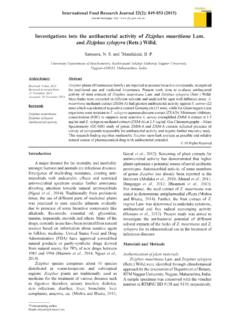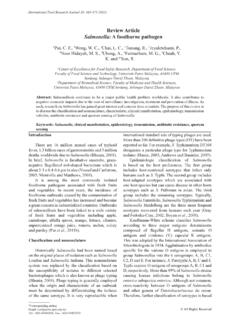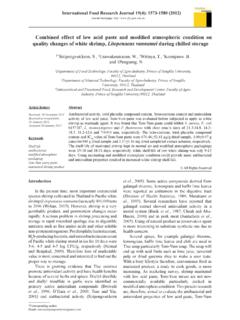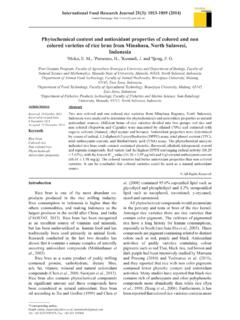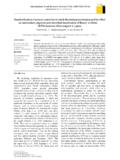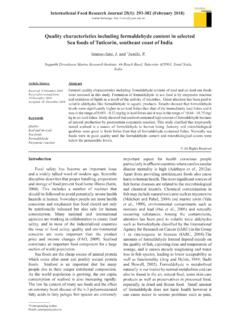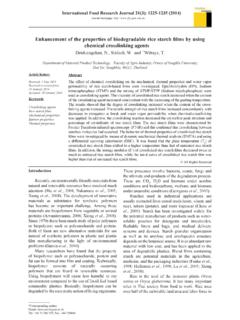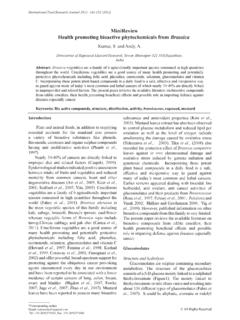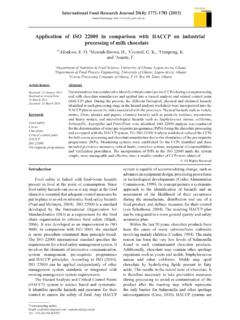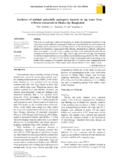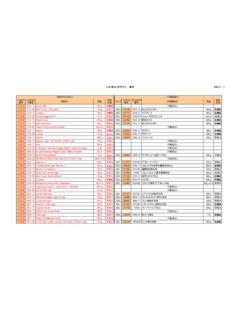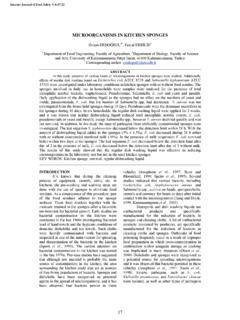Transcription of Saprophytic yeasts: effective biocontrol agents against ...
1 All Rights Reserved*Corresponding author. Email: International Food Research Journal 20(6): 3403-3409 (2013)Journal homepage: , Safety Research Center (FOSREC), Faculty of Food Science and Technology, Universiti Putra Malaysia, 43400 UPM, Serdang, Selangor, Malaysia Saprophytic yeasts: effective biocontrol agents against Aspergillus flavus AbstractAflatoxins are carcinogenic, mutagenic and teratogenic fungal toxins predominantly produced by Aspergillus flavus (A. flavus) and Aspergillus parasiticus (A. parasiticus). Members of the Aspergillus family are wound-invading pathogens that can infect pistachio trees and nuts. The pistachio nut is a favorite tree nut worldwide, and more than half of the world s pistachio production is from Iran. Pistachio nuts can easily be infected with Aspergillus spp.
2 Due to early splitting or due to animal, insect or physical damage. Any established infection of Aspergillus under high relative humidity and temperature results in the production and rapid accumulation of aflatoxins in pistachio nuts. It is impractical to remove aflatoxins from pistachio nuts after they are produced. Some microorganisms (such as Saprophytic yeasts) have been reported to have an antagonistic effect against Aspergillus spp. This study aimed to isolate Saprophytic yeasts from pistachio fruits and leaves and investigate their biocontrol activities against a toxigenic strain of Aspergillus flavus (A. flavus). Saprophytic yeasts were identified based on their morphological properties and biochemical tests. In total, 24 yeast isolates were obtained from pistachio fruits and leaves, and their antagonistic effect on A.
3 Flavus (PTCC 5006) was investigated. Five Saprophytic yeast isolates, displaying the highest biocontrol activities against A. flavus (PTCC 5006), were identified as Pseudozyma fusiformata, Cryptococcus albidus, Rhodotorula fragaria, Cryptococcus hungaricus and Rhodotorula hinula. The biocontrol activities of these yeast isolates were evaluated by their inhibitory effects on sporulation, colony expansion, biomass production and prevention of aflatoxin B1 (AFB1) production. Pseudozyma fusiformata was the most effective yeast isolate in terms of spore reduction ( ) and inhibition of AFB1 production ( ). Cryptococcus albidus produced the maximum reduction in fungal dry weight ( ). Based on these results, isolated Saprophytic yeasts from pistachio fruits and leaves can be used as effective biocontrol agents against the growth of Aspergillus and aflatoxin pistachio nut (Pistachia vera L.)
4 Is a favorite tree nut worldwide. Pistachio trees are widely cultivated in saline, hot and dry areas (Metheney et al., 1998) of Mediterranean countries, the Middle East and the USA. Iran has a significant share of the worldwide pistachio production, followed by the USA, Turkey, Syria, China and Greece (FAOSTAT, 2008; Zheng et al., 2012) and the majority of Iran s pistachio production is from Kerman, Rafsanjan. Pistachio nuts substantially contribute to the agricultural exports of Iran and are known as green gold in Iran (Aghdaie, 2009). Pistachio kernels are a rich source of oil and essential fatty acids for humans (Maskan and Karatas, 1999). Depending on the variety, the oleic acid content of pistachio kernels varies between , with linoleic acid contents between in pistachio kernels (Tsantili et al.)
5 , 2010). Pistachio kernels contain an average protein content of 20% (Tsantili et al., 2010) making them a good source of protein that can be added to snacks and confectionary products. Mycotoxins are secondary metabolites produced by filamentous fungi that are distributed worldwide and can contaminate a variety of foodstuffs. Mycotoxin contamination of food and feed is a serious health risk for humans and animals and has been raised as a high priority food safety issue during the past three decades (Afsah-Hejri et al., 2013a). Mycotoxin contamination of food and feedstuffs results in a significant economic loss both for producers and handlers (Herrman et al., 2002). Such negative impacts predominantly affect developing countries where pre-harvest, harvest and post-harvest techniques are not efficient enough to prevent the growth of contaminating fungi (Rustom, 1997).
6 Among all mycotoxins, aflatoxins (AFs) are the most important groups and attract a significant amount of attention due to their mutagenic, carcinogenic and teratogenic effects (Bhat et al., 2010). In warm and hot climates, AFs are predominantly produced by KeywordsAflatoxinsAspergillus flavus Saprophytic yeasts BiocontrolPistachio nutsArticle historyReceived: 12 September 2013 Received in revised form: 26 October 2013 Accepted: 30 October 20133404 Afsah-Hejri, 20(6): 3403-3409 Aspergillus spp., such as Aspergillus parasiticus (A. parasiticus) and Aspergillus flavus (A. flavus) (Afsah-Hejri et al., 2013a, 2013b). Aflatoxin B1 (AFB1) is the most toxic aflatoxin with the highest carcinogenic effects (Afsah-Hejri et al., 2011), and the presence of AFs in food and feedstuffs imposes serious health risks to humans and animals (Leszczynska et al.)
7 , 2000).Aspergillus family members are wound-invading pathogens. Pistachios can be easily damaged by early splitting, birds, insects or mechanical damage during harvest (Mahoney and Rodriguez, 1996). As a result of early splitting, damaging or cracking of the pistachio nut shell, Aspergillus spores can enter and infect the kernel (Sommer et al., 1986). Aspergillus spores enter through the split hull and colonize between the kernel and coat, where the relative humidity is high enough to support spore germination (Mahoney and Rodriguez, 1996). Infected kernels can rapidly accumulate AFs under high relative humidity and temperature (Diener et al., 1987). More than 80% of pistachio nuts split before harvest (in some varieties up to 94%) (Tsantili et al., 2010), making the kernel more susceptible to Aspergillus invasion and aflatoxin contamination.
8 Even small numbers of spores can result in high levels of AFs (some times more than the permitted level) under favorable growth conditions. Aflatoxin contamination of pistachio nuts significantly reduces the quality and value of pistachios and directly affects farmers and consumers. Product recall and bans from international export are problems associated with high levels of aflatoxin contamination in pistachios (Doster and Michailides, 1994; Ellis et al., 1991). According to the latest European Commission regulation, the maximum permitted level for nut products has been set at 2 ng/g for AFB1 and 4 ng/g for total AFs (Pearson et al., 1999; EC 1998; Sobolev, 2007). AFs are chemically stable during processing and storage. It is critical to avoid the conditions leading to aflatoxin formation during pre-harvest, harvest, transport and storage, which is not typically possible or achieved in practice (Bullerman and Bianchini, 2007; Kabak, 2009).
9 Although the aflatoxin level of agricultural products can be reduced by some chemical, biological and physical methods, it is almost impractical and very expensive to remove AFs after they are produced. Therefore, it is very important to prevent aflatoxin formation in the field. It has been reported that some microorganisms can be used as biocontrol agents against plant pathogens (Cook, 1993; Wilson and Wisniewski, 1989). Some yeasts have the capability to effectively compete with plant pathogens and can be used as biocontrol agents (Leibinger et al., 1997; Roberts, 1990; Yin, 2008). Saprophytic yeasts can be found on the surface of plant fruits and leaves. Under dry conditions, Saprophytic yeasts colonize plant surfaces and produce extracellular polysaccharides to enhance their survivability.
10 By producing extracellular polysaccharides, these yeasts restrict nutrient flow and inhibit the colonization of other microorganisms. Some researchers have used Saprophytic yeasts to control Aspergillus in nut trees (Hua et al., 1997, 1999; Hua, 2001; Palumbo et al., 2006). The aim of this study was to isolate Saprophytic yeasts from pistachio fruits and leaves and to investigate their biocontrol activity against Aspergillus. Materials and Methods Fungal strain A. flavus PTCC 5006 (toxigenic strain) was used as a positive control to test the biocontrol activity of yeast isolates. A. flavus PTCC 5006 has been demonstrated to produce AFB1. A. flavus PTCC 5006 was maintained on potato-dextrose agar slants (PDA). Water containing Tween-80 was used to resuspend the fungal spores, and a hemocytometer was used to count the number of spores in the of Saprophytic yeasts Ahmad aghaie is one of the pistachio varieties that displays early splitting.
